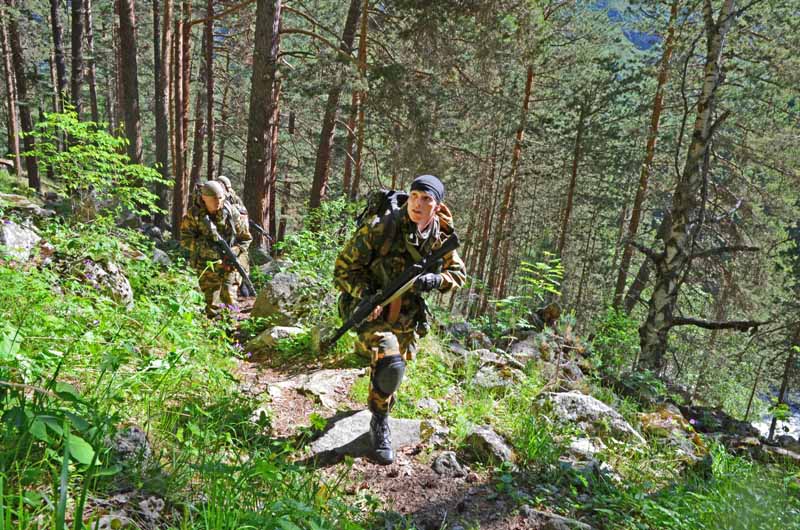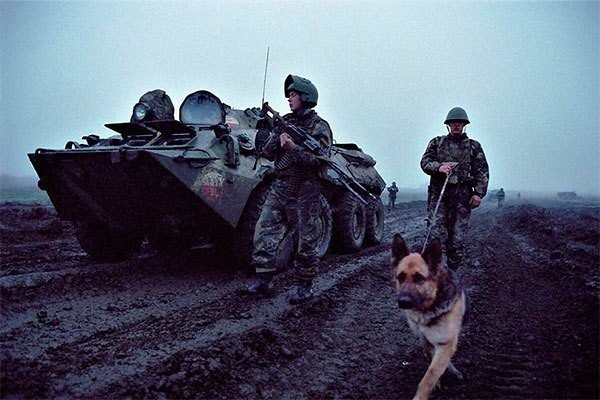
On the way caught in the mountain meets the most varied terrain (grassy slopes and scree, snow slopes and glaciers, mountain rivers and rocks, up to the vertical walls), overcome which requires special equipment, skills and abilities. Habitual walking on flat terrain is not applicable here. In the mountains requires a special style of movement, mountain walk.
Movement of the mountain relief requires a different tempo and rhythm, switching muscle groups, previously did not actively participate in the work, the ability to think at the same time and choose the safe way, watch your step, beware of falling rocks, constantly be on the alert. It is particularly important to be able to select the correct rate of movement, move smoothly, evenly transfer the body weight from one foot to the other. In order not to get tired ankles and calves, leg should be placed on the whole foot, rational use of the slope microrelief, trails. Rhythmic, quiet pace of movement will ensure correct functioning of the cardiovascular system and respiratory system. Well spent breathing is especially important at high altitudes.
An important role is played by the vestibular apparatus training. Balance when driving on a track with a heavy backpack, on the cusp of a rocky crest, icy terrain there is no innate natural, It produces training, special exercises.
With the change of climb within the steep slopes of 10 to 30 ° speed changes insignificantly, but significantly decreased with the rise of altitude. If height 3000 m above sea level is set 300 m in the time, on high 4000 m – about 200 m, and at the height of 5000 m – Total, 100 m. On the wall sections of the route due to the complexity of the rocky terrain movement speed may reach 30-40 m / in time, and that i 100 m. all day.
On the mountain slopes of 30 ° or more to move straight up hard and uncomfortable, especially on grassy slopes and ice. The steeper the slope, the more necessary to deploy the toe of the foot outward. Such a method unnatural movement for a person and leads to fatigue ankle. Therefore climbers overcome slopes more than 30 ° zigzag. The steepness of the slope of the zigzag on the rise depends on the steepness of the slope: What lay on, the zigzag cooler. The length of movement along the slope in one direction without reversal depends on the membership of the group and the nature of the slope. Zigzag so it is necessary to lay, the stones in case of failure from under the feet going ahead does not fall on the closing.
Earlier we talked about the general rules to overcome various mountain terrain, but there are special, when it comes to the slopes steeper than 30-35 °.
MOVEMENT grassy slopes, OSIPYaM, moraine
These forms of mountain terrain encountered on the way to the heights and passes. Technique to overcome them usually does not require special technical means, but it requires accuracy, care and special steps, different from the pitch of the plain. Movements should be smooth, uniform, leisurely. The only technical means of this relief is an ice ax, used as an additional point of support, and with an increase in the steepness of the slope – as a means of self-insurance.
MOVEMENT grassy slopes
Moving up the grassy slopes carried zigzagged, ice ax when changing direction of movement at all times to be at the ready and sent to the slope shtychkom, that at any moment when slippage could rely on him, it was possible to prevent the fall, sag samozaderzhanie.
The step length is determined by the steepness of rise: on a gentle relief steps lengthen,, of krutizne – respectively shortened.
Descent is carried out vertically downwards or, when using the Beaten Path, Zigzag. When descending a special burden falls on the calf muscles. Descents are sometimes long, and a special step is necessary climber. Leg supposed to put the whole foot (sock vertically downwards), throwing the foot forward, relaxing the calf muscle. Ice ax also is in position at the ready shtychkom to the slope, one hand while holding the head of the, other – the handle, and in the case of slip even one ice ax foot comes to the rescue.
regular breathing – a fundamental factor in the long-term load. On the heavy lifting breathing rhythm is consistent with the frequency steps. for example, left step – breath, step right- exhalation. For one cycle and may account for more steps, t. it is. at every step required inhale-exhale.
Uniformity in walking and breathing in the mountains keeps strength. Breath should be done not by mouth, and nose. This is especially relieves tension body during heavy.
With the change of slope steepness speed changes insignificantly.
The descent takes 1/2-2/3 time, spent on the rise. Rate of movement group on the climbs recommended such: 50 traffic minutes, 10 minutes of rest. Across 2-3 hours needed a light snack. It will resume supply of fast-digesting substances – sources of energy.
Heavy backpack significantly reduces the rate of movement and takes a lot of additional forces.
MOVEMENT scree
The principle of movement in the same scree, as on the grassy slopes. Debris can be fine, medium and large. There may be old, well packed, or mobile. The most dangerous medium, neslezhavshiesya scree. There are much higher possibility of failure and stones hitting people, under-reaching. Small mobile scree most difficult to overcome. Small fragments of rock crawl out from under the feet, and it is difficult to organize a solid, reliable foothold. Mountaineer takes a step up, and step with the foot crawls down, and it remains practically in place, like slips. On such scree need for a smooth, even movement, especially unacceptable sharp, jerky movements and jumping.
Average scree more resistant, but as pieces of clastic rocks are larger, it increases the risk of stone fall call or rockfall. To overcome this it is necessary to gently slough, slowly, looking for a firm foothold for the feet. When driving on average talus damage increases the risk of foot; careless statement of his feet on the stone can cause, that the stone, He slipped out from under her, shift and pull hard on the leg. Danger also hit the legs or arms into the crevice between the rocks.
A very peculiar way to overcome the large scree. Here, the time necessary to apply the elements of rock climbing, to move from one block of stone, on the other. The best place for an ice ax at this point – the strap of a backpack, since loss of balance or falling climber can cause them to injury.
During the descent the small moving debris is not only preferable, but sometimes it can cause and pleasure.
Choosing for launching sites, covered with fine gravel, you can easily slide along with the gravel under its own weight. Maybe even gliding in small steps.
When descending a scree straight down the middle, you can also move with the moving mass of stones, equalizing the rate of descent at a speed of movement of stones, without fear of falling, and only occasionally making 1-2 step towards, to skip past large rocks, already gained a significant rate of.
If small and medium scree slope is carried straight down, then the big scree and rock climbing piles of boulders falls down. It increases the probability of hitting the hands or feet into the crevice between the rocks, can shift large, dense stones lying, possible loss of balance.
MOVEMENT Moren
moraine – nahromozhdenye stones, that the glacier dragged along in the valley. according to the old, grassy moraines go easily and safely. Lateral moraine usually are extended, and that their crests are the main paths and trails along the glacier.
moraine, located directly on the glacier, the so-called median, constantly moving on glacier, in a state of precarious equilibrium. Supports for the feet is unstable. stones, composing a moraine, at any moment may be broken or slip aside, for they lie directly on the ice.
Particularly dangerous when passing fringing glacier steep lateral moraine. They are composed of a conglomerate – sand, cemented with separate different-sized stones. In dry weather, in this breed is difficult to make the step, in the rain as it becomes limp, Stones released and freely falling. Move along such portions must be accurately, and ice pick as the main pivot point is required. Human movement in the mountains influenced by many factors. Rain, wind, sudden changes in temperature are constantly changing situation in the mountains. Apparently safe in good weather, covered with grass and flowers in the rain slope becomes slippery and dangerous. moraine, which in dry weather it is difficult to make a step, even with the help of an ice ax, becomes a potent source of debris flows and rockfall when wet. stones, lying on the slope of a thousand years, podmytuyu water, falling, causing rockfalls.
If necessary traverse the lateral moraine of the slope should chart the way, free precariously lying in the nests of stones. When zigzag band movement in any case not be collected under each other
Any accidentally thrown stone can cause an avalanche of stones, bring it down on the bottom of his comrades walking. But given the complexity of the relief, moraine, quickly from them to go away and not to run away.
Typical of mountain strong winds, low temperatures, fogs, rainfall are specific dangers, which should be well aware of and avoid.











